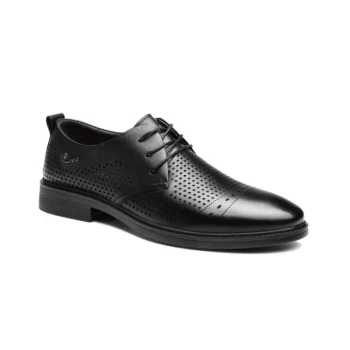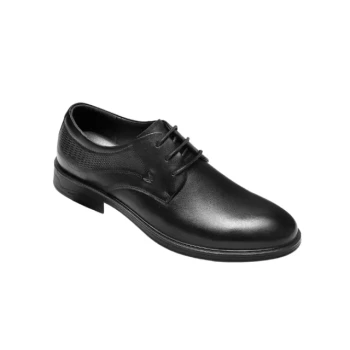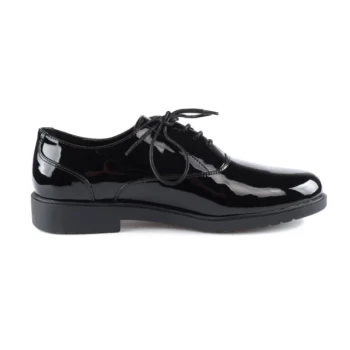In short, the insole is the interior layer of a dress shoe that sits directly beneath your foot. It serves as the primary point of contact, providing essential cushioning, support, and shock absorption for comfort. The quality and material of the insole are critical indicators of the shoe's overall craftsmanship and longevity.
The insole is the unseen foundation of a shoe's comfort and structure. While a simple foam insole offers immediate cushioning, a full leather insole signifies higher quality, offering superior durability, breathability, and the ability to mold to your foot over time.
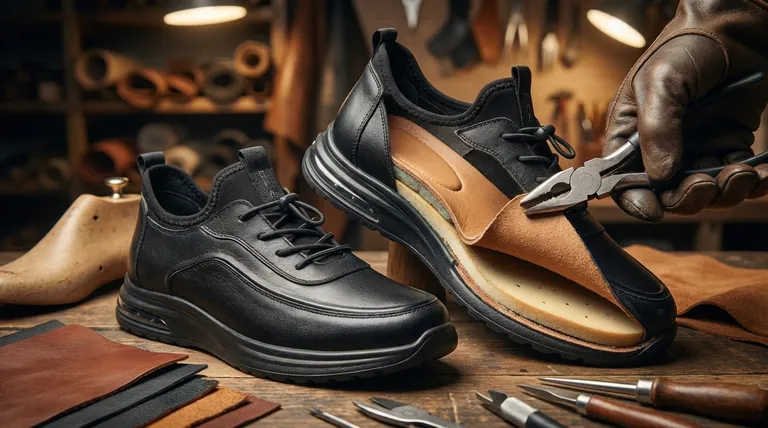
Deconstructing the Dress Shoe
To understand the insole's importance, we must first see where it fits. A dress shoe is comprised of two primary sections: the upper and the sole.
The Upper
The upper is everything you see on the top and sides of the shoe. It is typically crafted from high-quality leather and is responsible for the shoe's aesthetic, style, and protective structure.
The Sole Unit
The sole is the entire structure underneath your foot. It's not a single piece but a system of layers, including the insole and the outsole.
The outsole is the bottom-most layer that makes direct contact with the ground. It's built for durability and traction, often made from hard-wearing leather or practical rubber like Dainite.
The Insole's Critical Role
The insole is sandwiched between your foot and the outsole. Though often hidden, its role is fundamental to the shoe's feel and performance.
The Foundation of Comfort
The insole's primary job is to provide a comfortable, cushioned surface for your foot. It helps absorb the shock and impact generated with every step you take.
Providing Structural Support
A well-constructed insole also provides crucial support, particularly for the arch of your foot. It helps distribute your weight evenly, reducing fatigue over a long day of wear.
Common Insole Materials and Their Implications
The material used for the insole speaks volumes about the shoe's quality, durability, and intended use. The two most common materials are leather and cushioned foam.
Leather Insoles
A full leather insole is the hallmark of a high-quality, well-crafted dress shoe. Leather is durable, breathable, and has the unique ability to conform to the specific shape of your foot over time, creating a personalized fit.
Cushioned Foam Insoles
Foam insoles provide immediate softness and excellent shock absorption. They are common in more comfort-oriented or budget-friendly shoes but typically lack the durability and moisture-wicking properties of leather.
Understanding the Trade-offs: Leather vs. Foam
Choosing between insole materials involves balancing initial feel with long-term performance.
Durability and Longevity
Leather is exceptionally durable and will last for years, often for the entire life of the shoe. Foam, by contrast, will compress and break down over time, losing its cushioning and supportive qualities.
Breathability and Moisture Management
Leather is a natural material that breathes, which helps manage moisture and keep your feet cooler and drier. Synthetic foams can trap heat and moisture, which may lead to discomfort.
Initial Feel vs. Long-Term Fit
Foam insoles provide a plush, soft feeling right out of the box. Leather insoles are firmer initially and require a break-in period, but they reward your patience by molding into a custom-fit footbed that offers superior long-term support.
Making an Informed Choice
Your decision should be guided by your priorities for the shoe.
- If your primary focus is long-term durability and a custom fit: Insist on a dress shoe with a full leather insole.
- If your primary focus is immediate cushioning for casual or infrequent wear: A shoe with a quality cushioned foam insole can be a perfectly suitable choice.
Ultimately, understanding the insole empowers you to look beyond surface-level style and assess the true quality and comfort of a dress shoe.
Summary Table:
| Insole Material | Key Characteristics | Best For |
|---|---|---|
| Leather | Durable, breathable, molds to your foot over time | Long-term investment, superior craftsmanship, all-day wear |
| Cushioned Foam | Immediate softness, excellent shock absorption | Budget-friendly options, casual or infrequent wear |
Ready to craft or source premium dress shoes with high-quality leather insoles?
As a large-scale manufacturer, 3515 produces a comprehensive range of footwear for distributors, brand owners, and bulk clients. Our production capabilities encompass all types of shoes and boots, ensuring the structural integrity and lasting comfort that comes from superior insole construction.
Contact our expert team today to discuss your manufacturing needs and elevate your footwear line.
Visual Guide
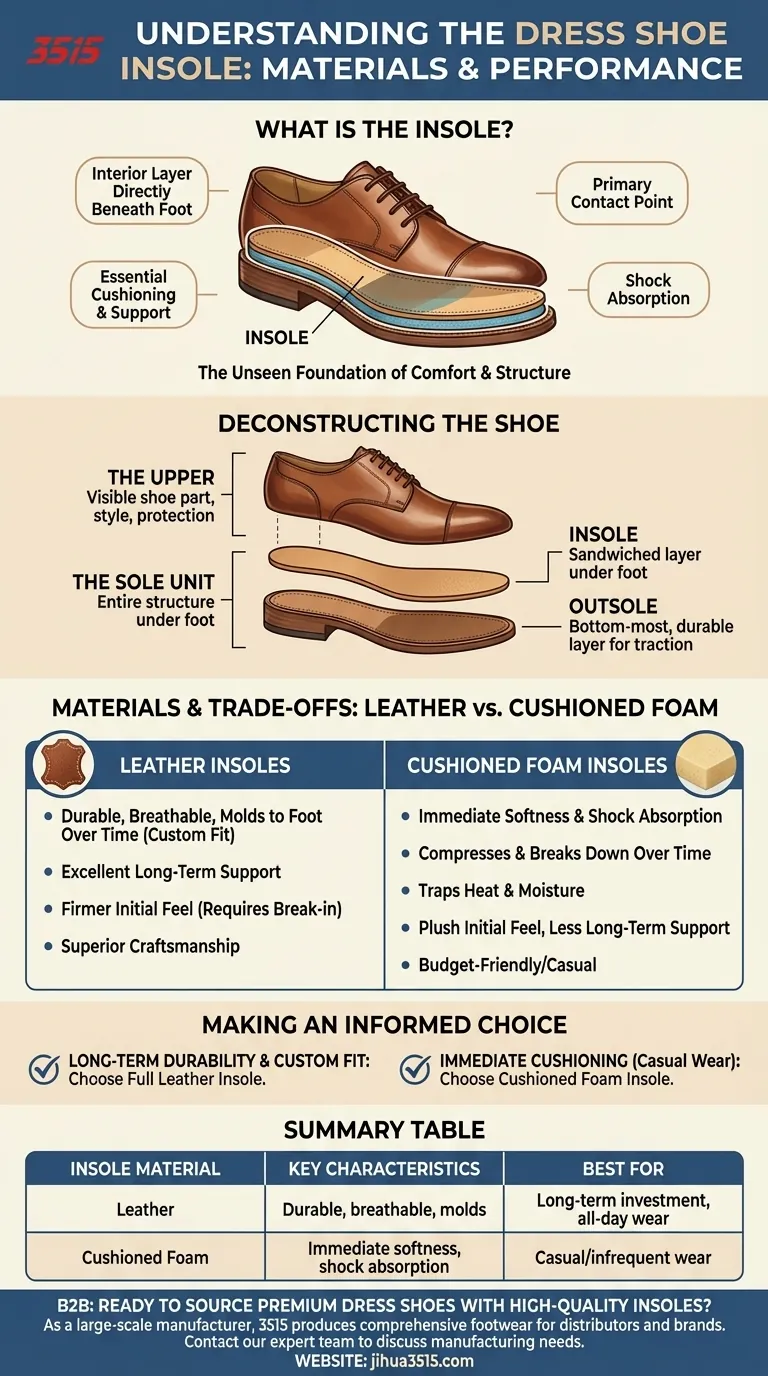
Related Products
- Custom Manufactured Air Cushion Leather Business Shoes for Wholesale
- Wholesale Leather Derby Shoes Manufacturer | Customizable Business & Dress Footwear
- Wholesale Comfortable Business Casual Shoes Custom Manufacturing
- Wholesale Breathable Perforated Leather Derby Dress Shoes for Custom Brands
- Classic Leather Derby Dress Shoes Wholesale & Custom Manufacturing
People Also Ask
- Why are sneakers now accepted in office environments? The Shift to Modern Professionalism
- How does leather compare to other shoe materials in terms of durability and comfort? A Material Guide for Footwear
- What are the characteristics of business casual sneakers? Master the Polished & Professional Look
- Are sneakers acceptable in a business casual workplace? How to Choose the Right Style
- What should be considered when choosing sneakers for a business casual office look? Achieve Comfort & Professionalism



